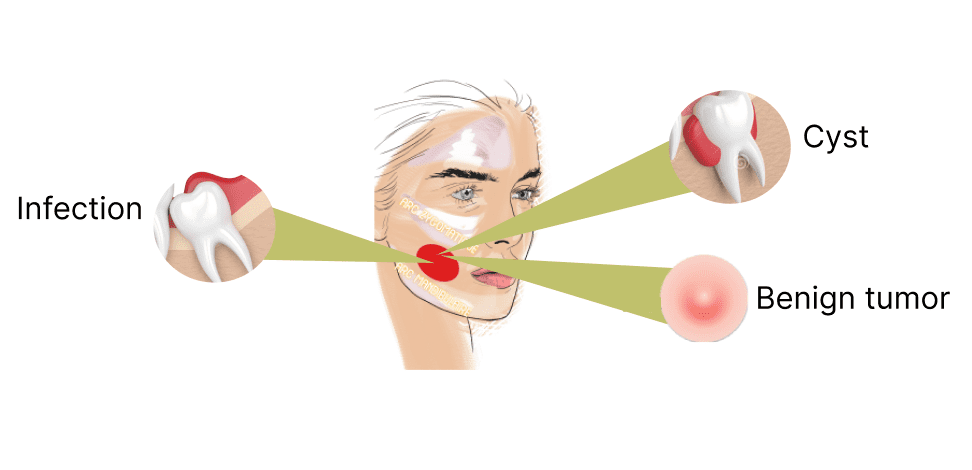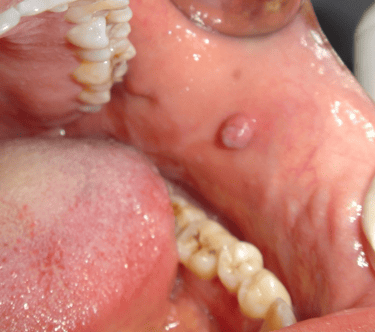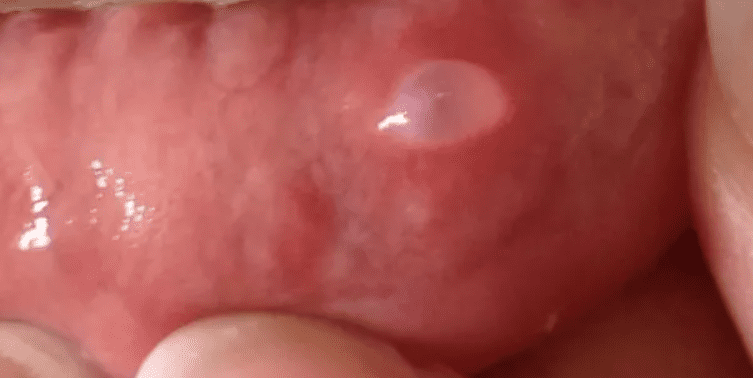What is this lump inside my cheek near my wisdom teeth?
 Wisdom teeth, being the last to erupt, are known to cause many problems. As they often do not find enough room to fit, they grow in the wrong direction. They can then bite and injure the cheeks when chewing, resulting in painful ulcerations or sometimes a small whitish, lumpy lesion.
Wisdom teeth, being the last to erupt, are known to cause many problems. As they often do not find enough room to fit, they grow in the wrong direction. They can then bite and injure the cheeks when chewing, resulting in painful ulcerations or sometimes a small whitish, lumpy lesion.
Other complications can also occur during the development of wisdom teeth, such as cysts, benign tumors, or infections.
Most of these complications are not serious and resolve as soon as you have your wisdom tooth treated. Still, it's a good idea to have it checked by a professional to identify the nature of the lesion and the best course of action.
What does a lump in the cheek near the wisdom teeth likely mean?
When wisdom teeth appear slightly tilted in the mouth, with the chewing surface pointed at the cheek, they can irritate and lead to ulcers or lumpy lesions.But these lumps aren't only because of wisdom teeth. Anything that keeps irritating the mouth over and over can cause weird growths or lumps to form. One common type is called Fibroma. It's the most common benign (non-cancerous) lump in the mouth, mostly found in people between 30 to 50 years old.
For example, if you're always accidentally biting your cheeks, using an old denture, or wearing braces, these things might be the actual cause.
So how does a Fibroma appear? Well, it's like a defense mechanism of our body to overcome chronic aggression.
The cells in that spot start growing a lot and make too much collagen. That ends up forming a firm, smooth lump that's usually around 1 to 2 centimeters wide. It doesn't usually hurt, and it blends in with the nearby tissue. But if you accidentally hurt or bite it, it might get red or white and swollen.

Fibroma inside the cheeks
Another possible cause of that lump is something called Mucocele. It's like a clear or bluish blister filled with fluid. This can happen when you've accidentally hurt a salivary gland, like by biting your cheek. When a tube in the gland that releases saliva into your mouth gets damaged, it can block the saliva and make a spot on your cheek to swell.

Mucocele on the lips
Less commonly, chronic and persistent irritation to the cheeks or any area of your mouth (tongue or lips) can progress into potentially precancerous conditions. That's because repeated and constant injuries may trigger abnormal cell changes that can significantly increase the risk of oral cancer.
So, even if it's unlikely to be anything serious, if you notice a sore or wound that won't heal, don't hesitate to see your dentist or doctor.
Treatment usually involves surgical removal of the growth. If the wisdom tooth is really behind the trouble, it may need to be extracted.
Other lumpy lesions that may be associated with wisdom teeth:
Various symptoms can coincide with the evolution and eruption of wisdom teeth. Again, most of these are benign and should not be a cause for concern as long as you have them checked by your dentist.The different types of lump lesions that can occur near the wisdom teeth include:
1. Infection:
One of the most common causes of swelling in the wisdom teeth area is an infection of the gum overlying the tooth, also known as pericoronitis. This happens when the tooth has just appeared above your gum but has not finished its eruption.
Bacteria and food debris can be trapped in this area and cause an infection of the gum surrounding the tooth.
Sometimes, a small piece of gum can partially cover the tooth and rub against the opposite teeth, aggravating the infection and pain.
Common symptoms of pericoronitis include:
- Intense pain that spreads to the jaws
- Pus discharge
- Difficulty opening the mouth
- Bad breath and bad taste in the mouth
- Swelling in the affected area
- Fever, loss of appetite, and swollen lymph nodes under the lower jaw
Left untreated, the infection can spread to the cheeks, causing diffuse swelling. This condition is called facial cellulitis and can become serious at an advanced stage.
If you notice a sign of infection, see your dentist as soon as possible to assess and treat the problem.
2. Cyst and tumor:
It is not uncommon to see a cyst or benign tumor around an emerging wisdom tooth, especially if it is impacted (embedded in the bone).
A study of 5486 impacted third molars found that the frequency of cysts was 2.24%, tumors 1.16% of which 0.05% were malignant (cancerous).
Usually, in their early stages, they develop silently and without symptoms. However, when they reach a significant size, they can deform the jawbone and even the face. This is why you should check your wisdom teeth regularly with your dentist to detect any problems early and prevent possible complications.
3. Other benign tumors of the mouth:
Other benign tumors on the cheek can be caused by:
- Viral infection, particularly by the human papillomavirus.
- Certain autoimmune diseases.
- Salivary gland tumors.
Other symptoms that can be associated with wisdom teeth
Wisdom teeth can evolve silently for years and then suddenly cause problems. Symptoms that can be associated with wisdom teeth eruption include:- Localized or radiating pain: The pain may be felt locally in the wisdom teeth area or extend to the jaws, ears and temporomandibular joint. It is a sign that the wisdom teeth are progressing through the bone and gums to their final position.
- Gum Inflammation: Red, swollen, bleeding gums in the back of the mouth can be associated with wisdom teeth.
- Infection: Wisdom teeth are more vulnerable to infection. Their position sometimes makes them hard to reach by the toothbrush, making them frequently affected by cavities.
How can I reduce the discomfort caused by a lump on my cheeks?
When you notice a lump near your wisdom tooth, the first thing to think about is seeing your dentist as soon as possible to identify the cause and decide on the appropriate treatment.The lump may be asymptomatic and not cause any pain. However, if you feel pain or discomfort, there are steps you can take to relieve yourself in the meantime.
- Make sure you practice good oral hygiene to reduce the bacterial load in your mouth and prevent potential infections.
- Rinse your mouth four times a day with salt water (half a teaspoon of salt in a glass of water) or alcohol-free mouthwash.
- Use over-the-counter pain relievers, such as Paracetamol.
- Alternate between hot and cold compresses for up to 10 minutes and see which one is the most relieving. Inflammation is often relieved by cold, while muscle pain is better relieved by heat or massage.
- Avoid scratching or biting the lump, as this can trigger or worsen the infection.
- Prevalence of cysts and tumors around the retained and unerupted third molars in the Indian population https://www.ncbi.nlm.nih.gov/pmc/articles/PMC4252379/
- Fibroma epidemiology and demographics https://www.wikidoc.org/index.php/Fibroma_epidemiology_and_demographics/
- Oral Medicine - Book by Michael A. O. Lewis and Richard C. K. Jordan
- Essentials of Oral Pathology - Book by Swapan Kumar Purkait
